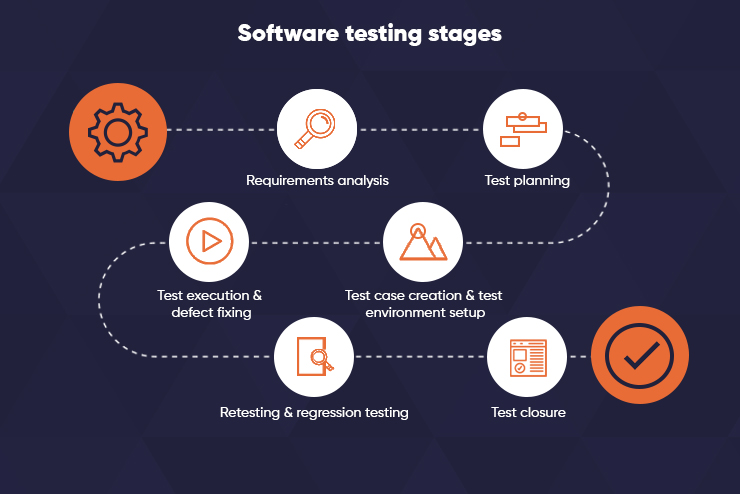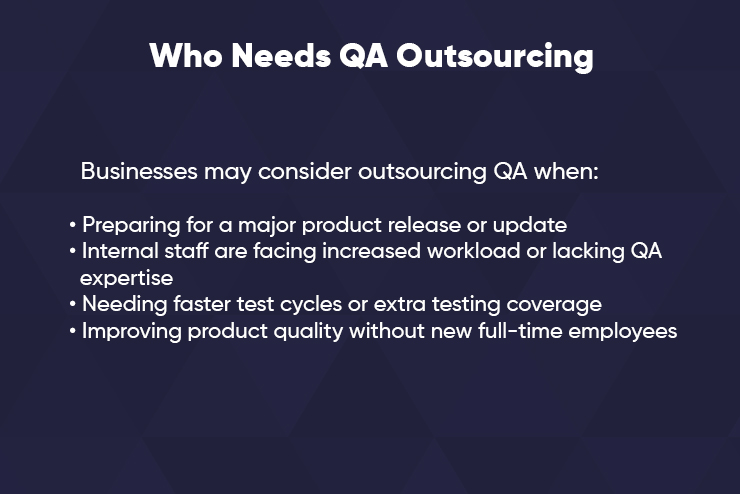5 Reasons Why Outsourced QA Is Better for Your Business
Mistakes are common in any task, but some can be too costly – especially in software development. To avoid mistakes that can easily ruin relationships with customers and reputations, companies rely on quality assurance: a crucial step to ensure product security and reliability.
But employing an entire team in-house is often too expensive. This is especially true for startups, while companies of all sizes are looking for ways to optimize costs and maximize product distribution.
One option that is becoming increasingly popular is outsourcing. More and more companies are turning to outsourced QA teams instead of hiring an entire team in-house. Thanks to its many benefits, this is an increasingly attractive alternative that can be adapted to companies of all sizes and streamline testing by reducing costs.

Our team has already touched upon the topic of outsourced QA in this article HERE.
But in this piece, we explore outsourcing QA as a strategic and smart move for any business type by highlighting the top 5 reasons why it’s better to farm out than hire in-house.
What is QA Outsourcing?
In a nutshell, outsourced QA means hiring an external company to perform software testing instead of hiring an in-house team. Companies can hire independent companies or groups of people to provide testing services for products.
So instead of recruiting, hiring and managing an entire team internally, companies can hire other companies to handle all testing tasks with little effort.
Outsourced QA is becoming quite popular.
So popular that the outsourced software testing market is expected to grow at a CAGR of 14.41% by 2028. The reason this is so widespread is because maintaining an in-house QA team can be both expensive and unnecessary. It requires resources, consumes time and can be overkill – especially for companies with a lot of short-term projects (e.g. start-ups, etc.).
There are different types of QA outsourcing, each tailored to a different profile and requirements. Choosing the right model can take some time, but it is very important.
The most common QA outsourcing models include hiring a dedicated QA team, on-demand testers, crowdsourcing, managed QA services and nearshore/offshore QA teams.
When you’re building fast, taking a lot of time and iterating constantly, the right QA setup can make the difference between success and failure.

A Dedicated QA Team
Imagine having a QA team that only works on your product, has learned the workflows and coordinates seamlessly with the developers. This is the dedicated team model.
A dedicated QA team works exclusively on the project. The team is embedded in the project as you would expect an internal team to be, except that they are not working full time for you. This model is ideal for companies with regular releases or very complex software systems.
It’s perfect for start-ups because:
- It offers consistent quality
- The scalability adapts to the growth of the company
- Fewer errors can creep into production
On-Demand Testing
Unlike dedicated teams, on-demand teams are only deployed when needed. On-demand testing refers to short-term testing services. Typically, on-demand testing is used for quick and efficient QA support, often just before product release.
This model is one of the best solutions when flexibility is a priority. On-demand testing is perfect for various requirements - whether regression testing before a new release or exploratory testing for a new feature – and is suitable for even the smallest organizations.
It’s perfect for bootstrapped teams or early-stage startups that have irregular testing requirements.
Again, startups love it because:
- There’s no overhead
- It’s available immediately
- It offers billing according to the " pay-as-you-go" principle
Crowdsourcing
A quick solution that is perfect for products that require real-world validation is crowdsourcing. Crowdsourcing QA means that the company uses a broad and diverse network of testers working in real-world conditions.
Products that need to be tested across different platforms, operating systems and devices often rely on crowdsourcing as it can provide valuable insights that internal QA staff may miss.
In other words, crowdsourced QA taps into a global pool of testers using real devices in real environments, allowing them to track down bugs for specific devices and provide quick and authentic feedback. It’s so popular that it’s considered one of the emerging testing trends for 2025.
In short, it’s great for:
- Feedback that in-house QA might miss
- Simulating real- user scenarios
- Excellent and fast bug discovery
Managed QA Services
Some companies prefer to focus entirely on development and growth and don’t have time to manage testers, write test plans and monitor QA cycles. Managed QA bridges this gap.
Managed QA services are a solution where you don’t have to worry about quality assurance. This means that they cover everything from planning and test execution to reporting and optimization.
It is practical for companies that want to offload the QA but still ensure the highest quality of products. In other words, it’s a complete QA department in a box.
Startups benefit from this because:
- Provides end-to-end QA
- Expert-level management with minimal effort
- Reliable and very consistent
Offshore and Nearshore QA
The last QA outsourcing model can be referred to as an offshore or nearshore team. They are not the same, but both offer the same benefits – access to a global pool of talent in a cost-effective way.
Offshore QA teams are typically more cost-efficient, while nearshore teams are easier to coordinate thanks to similar time zones. The decision between nearshore and offshore QA outsourcing depends on the company’s needs and priorities – lower costs or working in (almost) the same time zones.
The benefits of offshore/nearshore QA:
- Great for budget-friendly rates
- 24/7 coverage potential by covering different time zones
- Access to testers from all parts of the world
A Comparison of All 5 QA Models
| QA Model | Best For | Cost | Control | Commitment |
|---|---|---|---|---|
| Dedicated QA | Regular release cycles | $$$ | High | High |
| On-Demand Testers | Quick, short-term QA | $ | Medium | Low |
| Managed QA Services | Hands-off testing | $$ | Low | Medium |
| Crowdsourcing | Cross-device, real users | $$ | Low | Low |
| Offshore/Nearshore QA | Cost-saving, 24/7 testing | $-$$ | Medium | Medium |
In terms of costs, a dedicated QA team working off-site is the most expensive option, while on-demand testing and offshore QA testing are the most cost-effective options.
When it comes to control, some companies prefer little or no involvement in the QA processes. Crowdsourcing and managed QA teams are perfect for this. However, if organizations want to exert more control over the process, dedicated teams or nearshore QA may be a better choice.
Ultimately, the level of engagement between the company and the outsourced team reflects how much both sides invest in communication and integration in the long run. A dedicated QA team is the obvious answer for a high level of commitment, while startups looking to keep engagement to a minimum will opt for on-demand and crowdsourced testing.
The Disadvantages of Hiring In-House QA Teams
Although the idea that it’s always better to have an in-house team than hire an external one isn’t always true – nor does it apply to all areas of software development.
In this case, in-house QA teams can be more of a limitation than an advantage.
The sheer cost of hiring and onboarding may not be too high, but some companies (especially smaller ones) may not be able to afford the process. Not to mention that the hiring process is very time consuming and drains a lot of the company’s resources. All that time and money could be invested in other parts of the development process.
In addition to the financial and time costs, an internal quality assurance team can also be limited in terms of scalability. A team can be able to handle the normal workload with ease, but what happens during a period of high demand when the workload increases exponentially? Understaffing can be the icing on the cake when you are facing high work pressure, increased workload and strict deadlines.
While the same may happen with an outsourced QA team, that is far easier to solve as companies you’ve hired are more scalable and can easily adapt to fluctuations in demand.
Why Outsourcing Is the Better and Smarter Solution
It’s widespread and comes in many shapes and forms, but why is outsourcing QA a better solution than having a full-time team on the company payroll?
To begin with, it’s cheaper. Cost efficiency is one of the main reasons why companies are moving towards outsourcing software testing teams. It also offers better scalability and is generally more flexible than a permanent team working in the office.
In addition, training a team in new technologies can sometimes take a lot of time – time companies may not have. On the other hand, an outsourced team may be ready to go immediately, so the product can get to market faster than if a company relies on an in-house team.
But this is merely scratching the surface. Here are the top 5 reasons why outsourcing testing teams can be more beneficial than hiring an in-house team.
Cost Efficiency
Outsourcing can save money.
Companies that outsource testing avoid the long-term costs associated with hiring, training and maintaining full-time QA staff. When a company decides to outsource, it essentially eliminates expenses such as overhead, bonuses, benefits and salaries for staff that it would have to pay even if there were no current quality assurance project.
Hiring QA teams only when they are needed – for example, through a pay-as-you-go or contract arrangement – is great for financial scalability as it fits into any budget.
Scalability and Flexibility
Another advantage of hiring independent companies for QA is the greater flexibility in workload.
By this we mean that an external team is sometimes more flexible and adaptable than an internal team.
First, they can (in most cases) start work immediately and typically do not require time for training and research that a full-time QA team needs when facing a new technology or product.
Another great thing that outsourced teams offer is scalability. If you employ a full-time team and have fluctuating release cycles, the team may not be able to handle the increase in workload. With outsourcing, the company providing testing services will most likely be able to meet your needs and help you reach targets and product release on time.
Faster Time- to-Market
Besides quality, it is also important to get the product to market as quickly as possible. Outsourcing is an excellent solution for this.
Firstly, there is no need to waste time training the team (if necessary). Hired QA providers are ready to start testing almost immediately as companies look for independent companies and teams depending on their testing requirements.
Secondly, outsourced teams can perform testing in parallel with the development processes, significantly reducing the time it takes to prepare the product for release. The different outsourcing models will affect testing speed differently, but overall, the time it takes for the product to reach the market is shorter than when using in-house staff.
Access to Global Expertise
Technology and tools used in software testing are the critical part of formulating a testing strategy. With that in mind, hiring an independent company gives you the freedom to choose from a variety of companies that can handle testing.
Essentially, outsourcing gives businesses an opportunity to browse various QA providers and opt for those with the best qualifications: extensive expertise, access to the latest testing tools, and experience with proven or state-of-the-art technology.
This broadens the scope considerably and positively affects the overall quality of the testing process. It is possible to hire specialized testers for different areas without sacrificing time or resources.
More Focus on Core Business
With the help of a team handling software testing, the company has more time to focus on its core business. This means that the internal teams responsible for development and innovation have more time to focus on their respective tasks. Developers can focus on developing products instead of wasting time and energy on the various testing phases.
Instead, everything is done on time, thanks to the hiring of external teams of trained professionals. For large companies, this may not be a huge advantage, but for startups, where staff is a precious resource, the fact that a team has more time to focus on developing the product can be of great importance – and a deciding factor in opting for QA outsourcing.

How to Decide on an Outsourcing Model
Choosing the right outsourcing model depends on several factors, including company size, project complexity, budget and release frequency.
If the project in question needs the constant presence of a QA team with in-depth knowledge of the product, it might be smart to consider a dedicated team.
However, if the need is less frequent or more flexible, on-demand testers might be more suitable.
There is also a hands-off solution with end-to-end support: – managed QA services. For products where user diversity is a factor (or even a priority), the best solution would be crowdsourcing.
Finally, offshore or nearshore models are great for balancing cost and communication, as they leave you room for customization based on other preferences (e.g. adapting to time zones, etc.).
But how do you know which QA model to choose?
For start-ups, this can be a challenge. However, the basic criteria are as follows:
- Technology stack
- Reputation and track record
- Communication process
- Time zone
- Security procedures
- Tools and technology access
A reliable QA provider should be able to provide testimonials, case studies and sample reports that could prove the quality of the company.
In Conclusion: How to Know If QA Outsourcing Is Right For You?
QA outsourcing is more than a simple cost-saving measure. It is a strategic approach to improving software quality and optimizing internal resource allocation. Not to mention that it can help speed up product releases, which is one of the most important benefits for growing companies.
And because various models of QA outsourcing, it’s not just for small companies – large companies use it too. Companies of all sizes can easily find a solution that perfectly fits their budget and goals.
In short, working with the right QA team can be a perfect solution for a company that either wants to avoid the hassle of hiring and managing a team or doesn’t need a full-time QA team due to frequent short-term projects.
Before deciding to outsource, consider your organisation’s workload, release cycles, and quality standards for your product.
If you’re considering QA outsourcing, consider all your options and how you can best achieve your goals. Book a session with our team to learn everything you need to know about outsourcing QA directly from industry experts.
